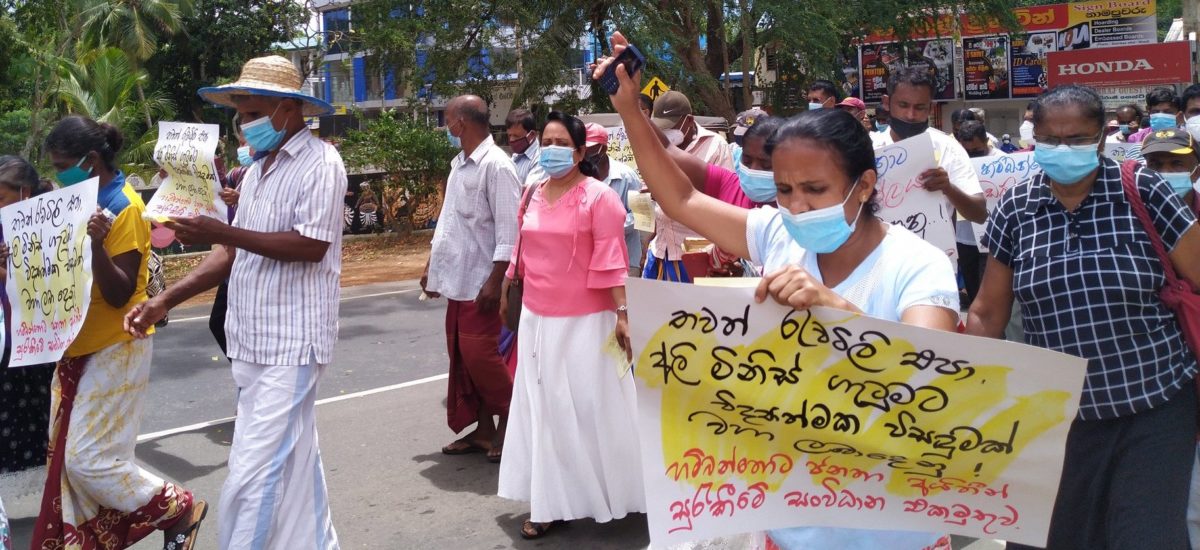Photo courtesy of Twitter
“This country can never be developed as long as there are environmentalists.” “Can we eat oxygen?” “Those who come to our villages and speak against development think that development should only be for Colombo people.” “Development is an act of conquering the environment for the benefit of humans.”
These are some of the ideas that were heard recently from various parties in the dialogues and debates on environment and development. The essence of these expressions is the notion that the environment should be sacrificed for development, that the environment and development cannot coexist. These ideas are more significant today as environmental destruction in the name of development is being implemented in various parts of the country. Environmental destruction is justified based on the notion that conquering the environment is necessary for the wellbeing of humans. Before being judgmental on this justification, we need to history and consequences of this justification. It will be useful to locate the specific issues and ideas that have been expressed in order to support destruction of nature in the name of development.
Anthropocentrism
The notion that humans are superior to non-human animals is known as anthropocentrism. This is the basis of the quotations. Humans are supreme according to this idea, and the world should be understood based on human values and experiences. Humans are supreme, and the environment including non-human animals could be utilized for the benefit of humans. Although this notion has become our general knowledge in our everyday life, it has not been same throughout human history. It had arisen in a certain era and had become the dominant ideology thereafter. Enlightenment marks the pinnacle of this idea. It happened in the backdrop of industrialization during the 17 to 18th centuries in the Western world.
We inherited the Western concept of modern anthropocentrism as a colonial legacy. Legitimization of an economic process that applauds the suppression of the environment for the economic gains of the human takes place in this thinking. Forests in the central highlands of the country were cleared for large scale plantations. A network of roads and railways was developed to link these areas with Colombo (as London, the colonial metropolitan was connected to Colombo) to transport the production of the plantations to metropolitan. The colonial economy destroyed about 30 percent of the forest cover in the country. This process was carried out with a victorious mindset of conquering the nature and establishing the human supremacy over it. For the first time in the history, elephants were seen as pests within this discourse. Accordingly, licenses were issued to hunt elephants who were a threat to plantations. As a result elephants in the highlands were close to extinction by the time of independence.
Development in the post-colonial Sri Lanka
Post-independence Sri Lanka also followed the same path of its colonizer towards development. Clearing forests and creating smallholdings was the main characteristic of the peasant colonization schemes which were implemented from 1930s. This process was accelerated by the post independent Sri Lankan state. In the traditional settlements, farmlands and residential areas were separate. Houses were not scattered. The new scattered settlements paved the way for a human-elephant conflict in dry zone. Roads were developed connecting the new settlements to main towns via forests. People built their houses along these roads considering the economic gain from the commuters of these roads. This linear settlement pattern further intensified the human-elephant conflict. Thus battle between human and nature became clearly visible.
The next phase of the battle started with the liberalization of economy. In 1980s 84,000 acres in Wellawaya were given to a British company to grow sugarcane. Elephants in the area were driven away. Visual of driving huge tractors imported of Britain to chase away the elephants who constantly returned to their homelands became a metaphor of the conflict between human and non-human animals. Today this type of large-scale industrial agriculture (sugarcane, corn, banana and mangoes) has expanded into millions of acres. Both in the rural and urban development approaches we have adopted are based on the anthropocentric notion of conquering the environment for the benefit of the human. The quotations at the beginning of this article have become normalized and entered into everyday vocabulary as a result of this process.
At this juncture, it is necessary ask what we have achieved from this development approach. If humans are supreme, at least they must have benefited from it. Unfortunately, this whole development approach has done nothing but create conditions that put the very existence of humankind under threat. The earth is becoming uninhabitable for the humans due to global warming and desertification. Clean air for breathing has become a luxury in many main cities in the world. Humankind’s existence has become endangered due to natural and man-made disasters. The end of humankind is feared due to the irreversible changes done to the environment. Humans have realized that although the environment could exist without them, they cannot exist without the environment. Anthropocentrism has lost its legitimacy and authority in the West today but postcolonial states such as Sri Lanka still carry forward the colonial legacy of anthropocentrism.
Most of the investments we welcome and embrace are mono crop commercial agriculture projects of foreign multinational companies. Throughout history, there has never been a visible benefit to the local population from these investments. Instead, they have threatened the right to health, land ownership and livelihoods of the local population. They have not only destroyed the forest cover and caused environmental destruction but also intensified the human-elephant conflict. Only a few who are close to power have benefited from these businesses but we continue to perceive these type of activities as the path to development.
Due to the lack of vision in the development approach, the city of Colombo has become warmer. Methods used by countries in high altitudes to retain heat such as laying interlock blocks and use of glass and concrete in construction have been applied here under a misguided notion of urban beautification, disregarding the methods that should be followed by a tropical country such as keeping the soil uncovered and maintaining tree cover over the roads. Instead of beautifying, they have converted the landscape into a concrete forest. Decisions such as clearing forests inhabited by elephants and other species for a renewable solar electricity projects clearly depicts how poor our thinking is.
What is happening in Walsapugala?
The protest initiated by the farmers of Walsapugala in Suriyawewa that has escalated into a fast unto death is significant in this context. Discussions and suggested solutions for human-elephant conflict are usually based on the thinking that humans and environment are distinct from each other. Solutions such as constructing electric fences and chasing away the elephants belong to this realm of thinking. Politicians gain cheap publicity by taking the side of humans in opposition to elephants and provide temporary solutions. But the farmers’ struggle in Walsapugala does not represent this traditional line of thought. They are demanding that government gazettes an Elephant Management Area for the elephants who are trapped in small forests due to deforestation and unplanned development in the Hambantota district. If this Elephant Management Area is declared, the elephants will get access to the Lunugamwehera, Bundala and Udawalawa sanctuaries. During last two decades thousands of acres of forests have been cleared for projects such as the Hambantota harbour, Mattala airport, Southern expressway and other connecting roads, and industrial agricultural projects. The current human-elephant conflict developed when the elephants lost their habitat due to these activities (it is even arguable that the local population or the national economy gained any economic benefits from these projects). Today Sri Lanka records the highest number of elephant deaths (405 in 2019) and second highest number of human deaths (121 in 2019) from human-elephant conflict in the world.
The people in Walsapugala are not demanding an electric fence or to chase away elephants into another area. For them, elephants are also victims, as are the farmers. They are speaking on behalf of both themselves and the elephants as the latter has no voice to do so. For the people of Walsapugala, both the humans and elephants have something in common to achieve: an environment where both could live freely. Although Cabinet approval has been given to the Elephant Management Area, the government continues to avoid declaring it officially. Meanwhile formal and informal actions are being taken to give away these lands to private investors for industrial agriculture and other projects. These actions are being justified in the name of development.
Farmers on the other hand represent a progressive stance of an eco-centric futuristic approach. Thus, the struggle of the farmers in Walsapugala presents an important alternative for the current dominant discourse on environment and development model of Sri Lanka. It is more significant because it is proposed by farmers in the forefront of the human-elephant conflict. The farmers believe in coexistence with the environment, beyond the outdated anthropocentric development. It is the duty of those who care for the wellbeing of all human and non-human animals to support of these farmers. In a country where majority follows a religion that teaches to care for all living beings (Siyalu sathvayo suvapath vethwa), we don’t need to think twice to support this struggle.


